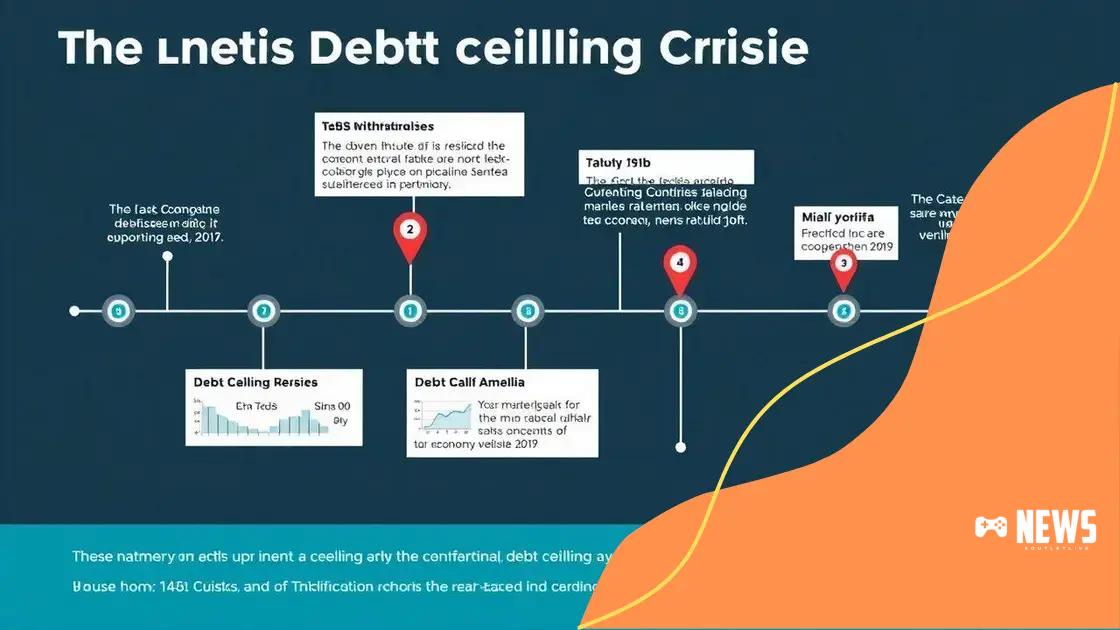Debt ceiling negotiations and market reactions: what you need to know

Debt ceiling negotiations directly impact market stability, personal finance, and investment strategies, with potential increases in interest rates and market volatility, significantly influencing consumer behavior and economic growth.
Debt ceiling negotiations and market reactions are critical components of the economic landscape. They can shape financial decisions, affect interest rates, and influence investor confidence. Curious about how it all unfolds? Let’s dive into the intricacies of these negotiations.
Understanding the debt ceiling concept
Understanding the debt ceiling concept is vital for grasping how national finances work. Simply put, it is the maximum limit the government can borrow to cover expenses. When this ceiling is reached, the government must negotiate an increase or face potential financial complications.
The debt ceiling has significant implications, affecting everything from social programs to government salaries. A failure to raise the ceiling could lead to a government shutdown, reduced services, or defaulting on debt. What does this mean for the average citizen? Understanding these consequences is crucial.
Key aspects of the debt ceiling
Several elements underpin the debt ceiling discussions:
- The relationship between revenue and spending
- The role of Congress in setting the ceiling
- The impact on the economy if the ceiling is not adjusted
These aspects are interconnected and help illustrate why negotiations are often complex. For example, when revenue from taxes falls short, borrowing becomes necessary to maintain government functions. This situation often leads to heated debates in Congress, where lawmakers must weigh the need for financial flexibility against concerns over national debt.
Historical context
To further grasp the debt ceiling, it helps to look at historical precedents. In the past, frequent adjustments to the ceiling have reflected economic conditions.
During times of economic downturn, more borrowing might be necessary. Conversely, in periods of growth, the focus may shift toward reducing debt. Understanding these patterns can provide valuable insights into future negotiations and market reactions.
In summary, recognizing the debt ceiling concept is essential for anyone wanting to navigate the financial landscape. The negotiations surrounding it can inform not only government policies but also broader economic trends.
Key players in the negotiations
Key players in the debt ceiling negotiations include various individuals and groups who significantly influence the outcomes. Understanding who these players are can help clarify the negotiation process.
The most notable players typically include members of Congress, especially those on the Senate and House committees. These committees often have the power to approve or deny changes to the debt ceiling. In addition, the President plays a crucial role, as his approval is necessary for any changes to become law. Political parties typically view the debt ceiling as an opportunity to promote their agendas.
Government officials and their roles
Several government officials are instrumental in these negotiations:
- The Secretary of the Treasury, who provides crucial data on the state of federal finances.
- Members of the President’s economic team, who are tasked with aligning economic strategies with political realities.
- Congressional leaders, who represent party interests during negotiations.
These players often debate the implications of raising the debt ceiling, weighing short-term benefits against long-term fiscal health. Their discussions can be heated, reflecting differing priorities and goals.
Interest groups and their influence
Beyond government officials, various interest groups also play significant roles. These groups can include:
- Financial institutions that represent banks and investors.
- Public advocacy organizations focused on social programs.
- Economic think tanks offering research and expert opinions.
These groups often lobby for their interests, influencing public opinion and the decisions of lawmakers. Their participation adds layers of complexity to the negotiations.
A clear understanding of these key players helps frame the climbing tension surrounding debt ceiling negotiations. This knowledge empowers citizens to stay informed about potential impacts on their personal finances and broader economic trends.
Historical context of debt ceiling crises

The historical context of debt ceiling crises reveals valuable lessons on how fiscal challenges have been handled in the past. Understanding these events can provide insight into current negotiations and market reactions.
One notable crisis occurred in 2011 when the United States faced a serious risk of default. As Congress debated whether to raise the debt ceiling, uncertainty spread through financial markets. Investors feared that a failure to act could lead to economic repercussions, and credit agencies threatened to downgrade the nation’s credit rating. The situation led to a last-minute agreement, but not without significant stress and market volatility.
Key historical events
Several events are critical in understanding debt ceiling crises:
- The 1995-1996 government shutdown, which showcased implications of a political stalemate.
- The 2011 debt ceiling crisis, where economic uncertainty caused market jitters.
- The repeated debt ceiling increases since the 1960s, reflecting a trend of mounting federal obligations.
These events highlight how the government’s fiscal decisions can shape not only the economy but also public perception. Each crisis has unique characteristics but often leads to similar outcomes—an urgent need to address the rising debt.
Lessons learned from past crises
Analyzing the historical context helps illustrate the recurring themes surrounding debt ceiling negotiations. Political parties often use these moments to assert their priorities, creating a tug-of-war between fiscal responsibility and necessary spending. Each negotiation reveals the delicate balance between governing and addressing the financial needs of the country.
Moreover, understanding the consequences of delayed actions can prepare citizens for future crisis scenarios. History shows that the outcome of debt ceiling negotiations can have lasting effects on the economy, impacting everything from interest rates to public services.
Market reactions to past negotiations
Market reactions to past negotiations regarding the debt ceiling can provide crucial insights into how financial markets respond to government decisions. Each negotiation has sparked varied responses, affecting investor confidence and economic stability.
For instance, during the 2011 debt ceiling standoff, uncertainty led to high volatility in stock markets. Investors were concerned about the potential for default, which could have disastrous effects on the economy. The debt ceiling debate dominated headlines, and as a result, stock prices fluctuated significantly, reflecting the anxiety of market participants.
Impact of uncertainty
Uncertainty influences how markets react. When negotiations are prolonged or contentious, as seen in 2013, investors often retreat to safer assets like gold and government bonds.
- Increased volatility in the stock market during negotiation periods.
- Rising demand for safe-haven investments like U.S. Treasuries.
- Market analysts’ downgrades of growth forecasts based on negotiation outcomes.
This behavior shows a clear pattern where markets respond not just to the negotiations themselves but to the uncertainty surrounding them. Lack of agreement can create ripples that impact everything from interest rates to consumer confidence.
Long-term consequences
The long-term effects of debt ceiling negotiations can be profound. Investors’ reactions today may shape future policies. For example, a failure to raise the ceiling historically has led to credit downgrades. The downgrade in 2011 by Standard & Poor’s marked the first time the U.S. credit rating was lowered, highlighting the market’s fear around default. This move had lasting implications, as it altered the perception of U.S. fiscal stability.
Understanding how markets reacted to these past negotiations can equip investors and the public with knowledge to navigate future debates about the debt ceiling. By learning from history, stakeholders can better anticipate potential impacts on their investments and the broader economy.
Implications for personal finance and investments
The implications for personal finance and investments during debt ceiling negotiations can be significant. Understanding these effects helps individuals navigate their financial decisions effectively.
When the government discusses raising the debt ceiling, it can impact interest rates. For example, if uncertainty rises, banks may increase rates on loans and credit. This change affects mortgages, car loans, and credit cards, making borrowing more expensive.
Investment strategies during negotiations
During debt ceiling debates, investors might alter their strategies. They often consider:
- Moving to safer assets, such as gold or U.S. Treasury bonds.
- Diversifying portfolios to mitigate risks associated with market volatility.
- Monitoring news closely to anticipate market moves based on political developments.
These strategies highlight how sensitive the investment landscape can be to government actions. Conscious adjustments can safeguard investments during uncertain times.
Impact on consumer behavior
The debt ceiling discussions can influence consumer confidence. If people perceive that the government may default, they may reduce spending. This behavior can slow economic growth as businesses respond by curtailing expansion or hiring.
Conversely, when negotiations conclude positively, consumer confidence can rebound. People may feel more secure, leading to increased spending and investment. This cycle illustrates the broader connections between government fiscal policies and individual financial habits.
In essence, staying informed about debt ceiling negotiations allows individuals to make better financial decisions. Navigating these implications can help in planning investments and managing personal finances more effectively.
FAQ – Questions about Debt Ceiling Negotiations and Market Reactions
What is the debt ceiling?
The debt ceiling is the maximum amount of money that the government is allowed to borrow to cover its expenses.
How do debt ceiling negotiations impact personal finance?
These negotiations can affect interest rates, making loans more expensive and influencing consumer spending.
What are the market reactions during debt ceiling discussions?
Markets often become volatile during these discussions, with investors shifting to safer assets, like gold or government bonds.
Why is it important to stay informed about the debt ceiling?
Staying informed helps individuals make better financial decisions, understanding how negotiations can impact their investments and finances.





